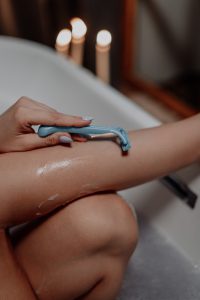Say Goodbye to Razor Bumps

Ingrown hairs, also known as razor bumps, are a common and frustrating skin issue that can occur after hair removal. While they can happen anywhere on the body, they are particularly common on areas like the legs, underarms, and bikini line. Fortunately, there are steps you can take to prevent and treat ingrown hairs, so you can say goodbye to the bumps for good and enjoy smooth, healthy-looking skin.
Exfoliate regularly
One of the main causes of ingrown hairs is dead skin cells that can block the hair follicle. By exfoliating regularly, you can remove these dead skin cells and help prevent ingrown hairs from forming. You can use a physical exfoliant, like a body scrub, or a chemical exfoliant, like a product that contains alpha or beta hydroxy acids. Just be sure to follow the instructions carefully and avoid over-exfoliating, which can cause irritation.
Our Picks:
- 100% Pure Blood Orange Body Scrub
- Glytone Exfoliating Body Wash
- Paula’s Choice RESIST Weightless Body Treatment 2 Percent BHA
Use a sharp razor
Dull razors can cause irritation and increase the risk of ingrown hairs. Be sure to use a sharp razor when shaving, and replace it regularly. You can also try using a razor with multiple blades, which can help reduce the chances of ingrown hairs.
Shave in the direction of hair growth
Shaving against the grain can increase the risk of ingrown hairs, so be sure to shave in the direction of hair growth. While this may not give you as close a shave, it will help prevent irritation and ingrown hairs.
Don’t shave too closely
Shaving too closely can cause the hair to curl back into the skin, leading to ingrown hairs. Leave a small amount of stubble when shaving, and don’t press too hard on the skin.
Use a shaving cream or gel
Shaving without a lubricant can cause irritation and increase the risk of ingrown hairs. Use a shaving cream or gel to help the razor glide smoothly over the skin.
Our Picks:
Apply a warm compress
If you do get an ingrown hair, applying a warm compress can help reduce inflammation and bring the hair closer to the surface. Soak a clean cloth in warm water, wring it out, and apply it to the affected area for 5-10 minutes. You can do this several times a day until the hair comes out.
Use a salicylic acid product
Salicylic acid is a beta-hydroxy acid that can help exfoliate the skin and prevent ingrown hairs. You can find salicylic acid products in the form of toners, serums, and spot treatments. Be sure to follow the instructions carefully and avoid using too much, as this can cause irritation.
Our Pick:
Avoid tight clothing
Tight clothing can rub against the skin and increase the risk of ingrown hairs. Wear loose-fitting clothing after hair removal to help prevent irritation.
Consider alternative hair removal methods
If you find that you are prone to ingrown hairs, you may want to consider alternative hair removal methods, such as waxing, sugaring, or laser hair removal. These methods can help reduce the risk of ingrown hairs, but they may not be suitable for everyone. Be sure to do your research and consult with a professional before trying a new hair removal method.
Moisturize regularly
Moisturizing regularly can help keep the skin soft and supple, which can reduce the risk of ingrown hairs. Look for a moisturizer that contains ingredients like glycerin or hyaluronic acid, which can help hydrate the skin.
Our Pick:

In conclusion, ingrown hairs can be a frustrating and painful skin issue, but there are steps you can take to prevent and treat them. By exfoliating regularly, using a sharp razor, shaving in the direction of hair growth, using a shaving cream or gel, and avoiding tight clothing, you can help reduce the risk of ingrown hairs. If you do get an ingrown hair, using a warm compress and a salicylic acid product can help treat the issue. And if you find that you are prone to ingrown hairs, consider alternative hair removal methods or consult with a professional. By following these tips and taking care of your skin, you can say goodbye to razor bumps for good and enjoy smooth, healthy-looking skin.

